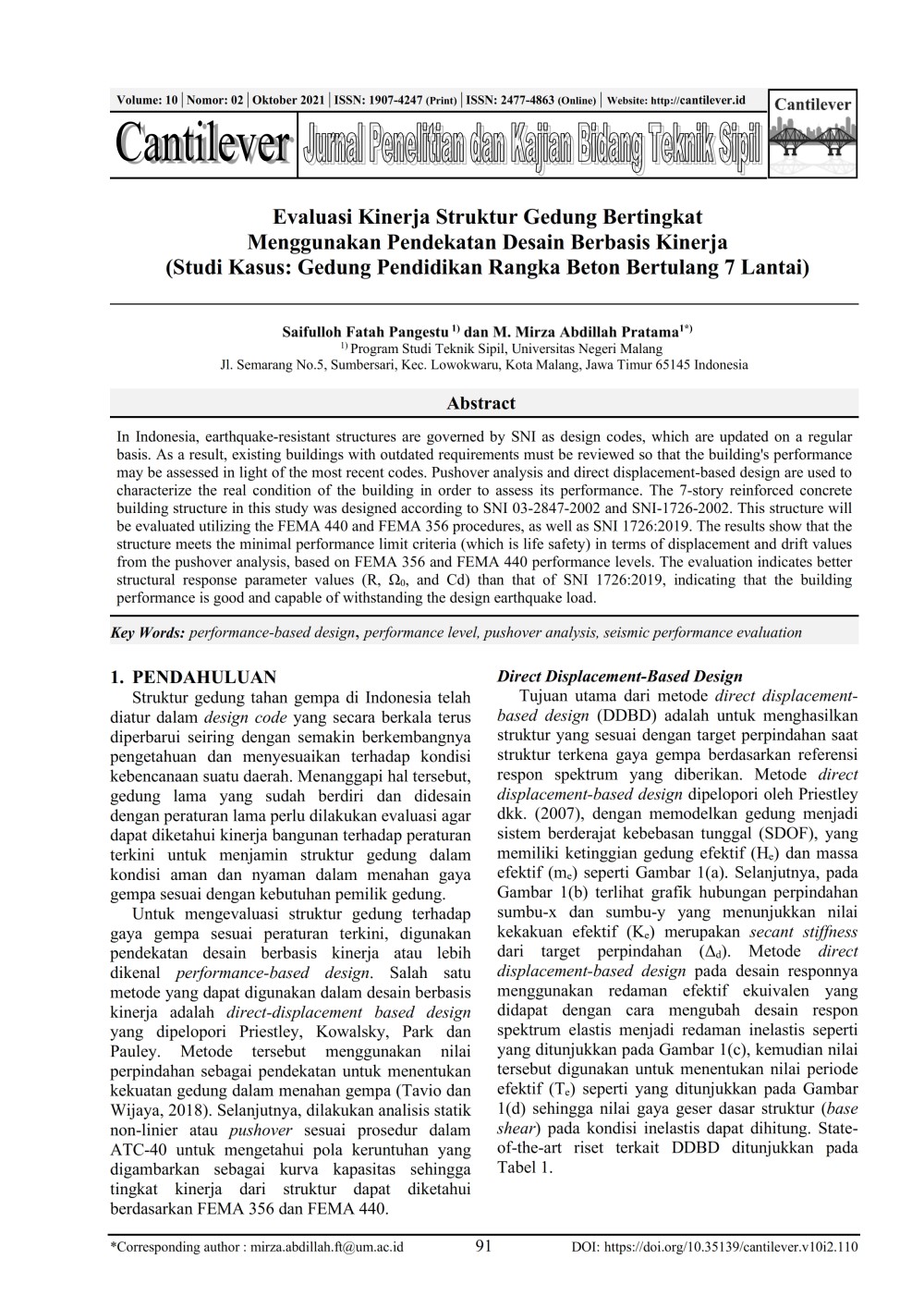Evaluasi Kinerja Struktur Gedung Bertingkat Menggunakan Pendekatan Desain Berbasis Kinerja (Studi Kasus: Gedung Pendidikan Rangka Beton Bertulang 7 Lantai) Performance Evaluation of Multi-Story Building Structures Using a Performance-Based Design Approach (Case Study: 7-Story Reinforced Concrete Frame Educational Building)
Main Article Content
Abstract
In Indonesia, earthquake-resistant structures are governed by SNI as design codes, which are updated on a regular basis. As a result, existing buildings with outdated requirements must be reviewed so that the building's performance may be assessed in light of the most recent codes. Pushover analysis and direct displacement-based design are used to characterize the real condition of the building in order to assess its performance. The 7-story reinforced concrete building structure in this study was designed according to SNI 03-2847-2002 and SNI-1726-2002. This structure will be evaluated utilizing the FEMA 440 and FEMA 356 procedures, as well as SNI 1726:2019. The results show that the structure meets the minimal performance limit criteria (which is life safety) in terms of displacement and drift values from the pushover analysis, based on FEMA 356 and FEMA 440 performance levels. The evaluation indicates better structural response parameter values (R, Ω0, and Cd) than that of SNI 1726:2019, indicating that the building performance is good and capable of withstanding the design earthquake load.
Downloads
Article Details
Aditama, W. (2017). Studi Perbandingan Gedung Beton Bertulang Dengan Ketidakberaturan Geometri Horizontal dan Vertikal Tanpa Soft Story dan Dengan Soft Story pada Lantai Dasar. Skripsi. Bandung: Jurusan Teknik Sipil Universitas Katolik Parahyangan.
Ardian, A. D. (2015). Analisis Pengaruh Perubahan Nilai Koefisien Modifikasi Respon (R) terhadap Perilaku Dinamis Struktur Gedung Tidak Beraturan. Skripsi. Yogyakarta: Jurusan Teknik Sipil Universitas Gadjah Mada.
ATC-40. (1996). Seimic Evaluation and Retrofit of Concrete Buildings, Vol. 1. California: Applied Technology Council.
Budiono, B. (2017). Contoh Desain Bangunan Tahan Gempa dengan Sistem Rangka Pemikul Momen Khusus dan Sistem Dinding Struktur Khusus di Jakarta. Bandung: Penerbit ITB.
FEMA 356. (2000). Prestandard and Commentary for the Seismic Rehabilitation of Building. Washington, D.C.: Federal Emergency Management Agency.
FEMA 440. (2005). Improvement of Nonlinear Static Seismic Analysis Procedures. Washington, D.C.: Federal Emergency Management Agency.
Lu, Y., Hajirasouliha, I., & Marshall, A. M. (2018). Direct Displacement-Based Seismic Design of Flexible-Base Structures Subjected to Pulse-Like Ground Motions. Engineering Structures, 168, 276–289. https://doi.org/10.1016/j.engstruct.2018.04.079
Pourali, N., Khosravi, H., & Dehestani, M. (2019). An Investigation of P-Delta Effect in Conventional Seismic Design and Direct Displacement-Based Design Using Elasto-Plastic SDOF Systems. Bulletin of Earthquake Engineering, 17(1), 313–336.
https://doi.org/10.1007/s10518-018-0460-3
Prabowo, A. & Lase, Y. (2016). Tinjauan Nilai Faktor Modifikasi Respon (R) dan Faktor Kuat Lebih (Ω0) pada Struktur Gabungan Rangka Baja dan Rangka Beton Bertulang dengan Analisis Pushover. Jurnal Teknik Sipil ITB, 23(1), 75-88.
Prakosa, A. Y. & Wibowo, A. (2018). Desain Rekayasa Gempa Berbasis Kinerja Dengan Metode Direct Displacement Based Design (DDBD). Jurnal Mahasiswa Jurusan Teknik Sipil, 1(2.
Priestley, M. J. N, Calvi, G. M., & Kowalsky, M. J. (2007). Displacement-Based Seismic Design of Structures. Pavia: IUSS Press.
Puspita, A. D. & Rosyidah, A. (2019). Force Based Design and Direct Displacement Based Design for Dual System Structure. Logic : Jurnal Rancang Bangun Dan Teknologi, 19(3), 162.
https://doi.org/10.31940/logic.v19i3.1454
Rahgozar, N. & Rahgozar, N. (2020). Extension of Direct Displacement Based Design For Quantifying Higher Mode Effects on Controlled Rocking Steel Cores. The Structural Design of Tall and Special Buildings, 29(16). https://doi.org/10.1002/tal.1800.
Standar Nasional Indonesia 1726. (2002). Tata Cara Perencanaan Ketahanan Gempa Untuk Struktur Bangunan Gedung Dan Non Gedung. Jakarta: Badan Standarisasi Nasional.
Standar Nasional Indonesia 1726. (2019). Tata Cara Perencanaan Ketahanan Gempa Untuk Struktur Bangunan Gedung Dan Non Gedung. Jakarta: Badan Standarisasi Nasional.
Standar Nasional Indonesia 2847. (2002). Tata Cara Perhitungan Struktur Beton Untuk Bangunan Gedung. Jakarta: Badan Standarisasi Nasional.
Tavio, Wijaya. (2018). Desain Rekayasa Gempa Berbasis Kinerja (Performance Based Design), Edisi II. Yogyakarta (ID): Andi Offset.
Tazarv, J. & Mohebkhah, A. (2021). Direct Displacement-Based Design of The Linked Column Steel Frame System, Part 2: Development and Verification. Structures, 31, 29–48.
https://doi.org/10.1016/j.istruc.2021.01.075
Xiao, Y., Zhou, Y., & Huang, Z. (2021). Efficient Direct Displacement-Based Seismic Design Approach for Structures with Viscoelastic Dampers. Structures, 29, 1699–1708. https://doi.org/10.1016/j.istruc.2020.12.067.

This work is licensed under a Creative Commons Attribution-NonCommercial 4.0 International License.
Authors who publish with this journal agree to the following terms:
- Authors retain copyright and grant the journal right of first publication with the work simultaneously licensed under a Creative Commons Attribution-NonCommercial 4.0 International License that allows others to share the work with an acknowledgment of the work's authorship and initial publication in this journal.
- Authors are able to enter into separate, additional contractual arrangements for the non-exclusive distribution of the journal's published version of the work (e.g., post it to an institutional repository or publish it in a book), with an acknowledgment of its initial publication in this journal.
- Authors are permitted and encouraged to post their work online (e.g., in institutional repositories or on their website) prior to and during the submission process, as it can lead to productive exchanges, as well as earlier and greater citation of published work (See The Effect of Open Access).
